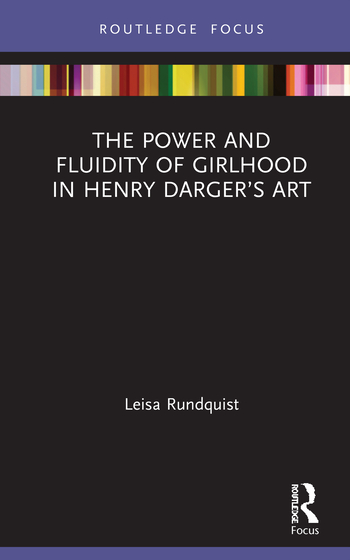The Power and Fluidity of Girlhood in Henry Darger’s Art, by Leisa Rundquist, Routledge, New York, 126 pages, 13 b/w Illustrations, 2021. ISBN: 9781138314559. Hardcover, $59.95

In this admirably concise volume, Lisa Rundquist works diligently to normalize Henry Darger.
That seems like fair play considering how he’s been pathologized. Being a working-class self-taught artist and a loner made him vulnerable to whatever excesses of interpretation anyone wanted to throw at him. The eccentric and sometimes extreme nature of his art was a contributing factor. But, in effect, Darger remained a victim of the same epithet applied to him in his youth: “Crazy.”
Rundquist makes the broad point that much of what is so disturbing and befuddling in Darger’s work is a function of the intensity of feeling that he struggled to communicate—an intensity reflected in his religious passion, his devotion to his enormous creative project and his own personality (characterized, as he himself wrote, by great bouts of anger and frustration).
She drills deeper, of course. And the power of this book is in her close analysis of Darger’s sources and culture, especially the specific strands of influence from his devotion to Roman Catholicism. She makes the case that Darger’s obsessive treatment of little girls, including the naked girls and, especially, the notorious naked girls with penises, might have less to do with pathology and perversion and more with religion. The church has a long tradition of gender-bending saints like Joan of Arc, and Darger was almost certainly aware of them.
In that tradition, she writes, “becoming male marks the transcendence of gendered differences and thus, access to holiness.” The argument is not watertight, but it’s plausible, and it explains Darger’s imagery more effectively than many earlier, even more speculative and far more sensationalized accounts.
She also makes a convincing case that Darger’s treatment of little girls reflected common attitudes toward children in his time, up to and including the violent scenes that are a source of major discomfort for audiences today. They are excessive by any standard, but that doesn’t mean they are predatory or simply gratuitous.
“Modeling his little heroines after a bevy of rebellious, orphaned girls and virtuous female martyrs, Darger understood girlhood in his story as a journey of suffering and self-abnegation,” a kind of journey hardly unique to Darger’s imagination, Rundquist points out.
She shows just how much the work of this “outsider” was influenced by the culture in which he was immersed. It’s a reminder that while the term outsider can accurately reflect an artist’s position with regard to the academic art world, it is and almost always has been a misnomer when intended to mean isolation from culture as a whole.
Rundquist is not alone in this re-imagining of Darger. She draws on the work of Michael Moon and Mary Trent, among others who have explored alternatives to psychiatric explanations of Darger and his work.
None of this says we should find that work comfortable—comfort was clearly not his intention. Even the moments of sweetness, of which there are many, to a great extent function as intensifiers for the moments of horror. “Seemingly powerless, the image of the cute little girl exudes a powerful aesthetic that manipulates the artist and viewer, alike,” Rundquist writes.
“Visualizing spiritual properties through the flesh of his little girl figure, a diminutive female, Darger raises the stakes to higher levels of sacredness and sentimentality as she becomes the ultimate site for suffering and Christian love…
“Extreme crucifixions, disembowelments, and gore become necessary in his quest to articulate the intensity of spiritual release.”
Perhaps we should consider the extent to which we resent Darger for so effectively drawing us into this horrific drama. It’s easier when we can maintain a comforting distance between ourselves and the eccentric and sometimes disturbing messages of artists like Howard Finster, Royal Robertson and Jesse Howard. Part of Darger’s particular power is in how he still succeeds in collapsing that distance.
This review originally appeared in The Outsider magazine, published by Intuit: The Center for Intuitive and Outsider Art.
